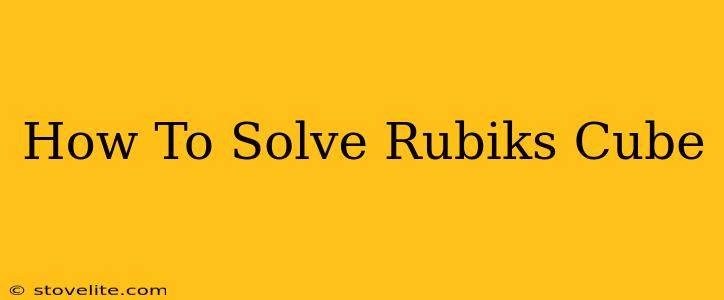The Rubik's Cube: a seemingly impossible puzzle that has captivated minds for decades. But don't worry, solving it isn't as daunting as it looks! This guide breaks down the process into manageable steps, making it achievable for anyone, regardless of prior experience. We'll cover the beginner's method, a popular and effective approach. Get ready to conquer this iconic puzzle!
Understanding the Method: Layer by Layer
The beginner's method focuses on solving the Rubik's Cube one layer at a time. This systematic approach prevents overwhelming complexity and allows you to build upon each step. We'll use standard Rubik's Cube notation to describe the moves. Don't worry if you're not familiar with it; we'll explain the necessary notations as we go.
Step 1: The White Cross
This is the foundational step. Your goal is to create a white cross on the top face (usually white). This involves manipulating the edge pieces (the pieces with two colors) to create the cross. There is no one "right" way, but focus on getting the white edges in their correct positions and orientation. Try to work intuitively, moving pieces into position using basic turns and rotations. Don't worry about the corners yet!
Step 2: Completing the First Layer (White Corners)
With the white cross complete, it's time to solve the white corners. This involves bringing the white corner pieces into their correct positions, completing the first layer. This step will require a few algorithms (sequences of moves). You can easily find visual tutorials online demonstrating these algorithms – searching for "Rubik's Cube beginner's method white corners" will yield plenty of helpful resources.
Step 3: Solving the Middle Layer
Now for the middle layer! This involves bringing the edge pieces from the second layer into their correct positions without disturbing the already solved first layer. This step might seem tricky initially, but the algorithms involved are relatively straightforward and easily learned through practice and visual guides. Searching for "Rubik's Cube middle layer solution" online will help you visualize the moves.
Step 4: Orient the Yellow Layer
This step focuses on the yellow face. The goal is to get all the yellow pieces oriented correctly, forming a solid yellow top. There's a specific algorithm used for this, often referred to as the "OLL" (Orient Last Layer) algorithm. Again, visual learning is key here; YouTube tutorials are invaluable for understanding this step.
Step 5: Permute the Yellow Layer
The final step! The yellow face is now yellow but the pieces might be in the wrong positions. You'll need the "PLL" (Permute Last Layer) algorithms to arrange the yellow pieces correctly. There are several PLL algorithms; mastering a few will suffice. Searching for "Rubik's Cube PLL algorithms beginner" will provide many visual resources.
Tips for Success
- Practice Makes Perfect: The key to mastering the Rubik's Cube is consistent practice. Start slowly, focusing on understanding each step before moving on.
- Use Visual Aids: YouTube tutorials are incredibly helpful. Visualizing the algorithms is crucial for understanding the moves.
- Don't Give Up: It might seem frustrating at times, but perseverance is key. With practice, you'll be solving the cube in minutes!
- Find a Method that Works for You: While the beginner's method is popular, other methods exist. Explore and find the one that best suits your learning style.
Beyond the Beginner's Method
Once you've mastered the beginner's method, you can explore more advanced techniques. These methods can significantly reduce solve times. Consider exploring:
- CFOP (Fridrich Method): A much faster method that relies on more complex algorithms.
- ZZ Method: Another advanced method known for its speed and efficiency.
Solving a Rubik's Cube is a rewarding experience. With dedication and practice, you'll progress from a beginner to a seasoned solver. So grab your cube, start practicing, and enjoy the journey!

